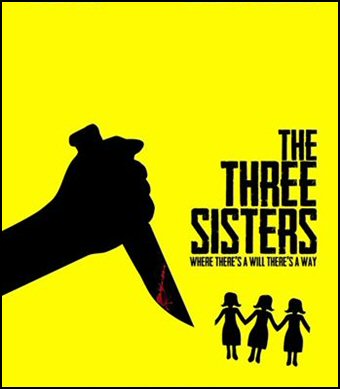
A middle-aged man (Henry McNab) fidgets around his home, something evidently playing on his mind. He retires to the bathroom ... Moments later, we see him slumped in there, a bloody gunshot having put an end to his life.
The plot thickens when his niece Emma (Selena Walsh) is murdered in her apartment mere days later.
Enter Sarah (Gillian Walsh), sister to the most recent victim and sufficiently fretful for her own safety to recognise that staying with her ailing, bedridden father (genre legend Giovanni Lombardo Radice) and steely mother (Jacinta McNab) is not such a good idea. Ergo, she pays a visit to ex-boyfriend Dylan (Elliott Moriarty) and appeals to his better nature.
Sure enough, Dylan is more than happy to put her up for a while in his own flat. He does, after all, have designs on winning her back.
In the meantime, an unnamed but highly sardonic detective (Neill Fleming) begins sniffing about, convinced that further investigations will reveal a link between the uncle's apparent suicide and Emma's brutal slaying.
Events escalate when it's revealed that the uncle left a fortune in his will to Sarah, Dylan finally gets her into the sack, and her other sister - Sinead (Sinead Moloney) - appears on the scene.
It may also sound simple enough.
But factor into this scenario a hitherto unseen brother; a piece of scrap paper containing a scrawled clue which is as obscure as it is integral; mystery voices proffering grave messages over the telephone; Dylan's mate who's eager to help with the running of the late uncle's business ... and the scene is set for an unexpectedly riveting ride propelled largely by Dylan's insistence that he will have more luck solving the unfurling murder mystery himself than relying on the hapless police to do so.
As the film progresses, the one thing he and Sarah aren't short of are suspects.
Daire McNab not only wrote and directed THE THREE SISTERS, he also acted as the film's producer, its principal camera operator and helped handle the moderately gory FX work alongside his relatives Henry and Rory. He's done an impressive job, across the board.
Stylistically, the film is clearly indebted to the giallo cinema of the 1970s. Fluid camera motions, painstaking attention to seemingly throwaway details and keen use of primary colours during the meticulously crafted set-pieces work alongside Repeated Viewing's savvy score, which at times recalls that of Argento's TENEBRAE.
Genre motifs are rife too. The black-gloved killer is present and correct, of course. Canny little touches such as creepy diminutive figures rushing by in the background while oblivious characters busy about their homes work well. A cameo from a renowned Italian presence always helps and Radice fulfils this role nicely. Taut editing and a dreamlike feel to some of the film's more offbeat moments proffer subtler but no less well-observed nods to gialli. Naturally, all of these impressive factors are wrapped up in a tightly constructed, satisfying whodunit plot.
If it all sounds like another classic case of style over substance, a la the visually impressive but narratively vacuous films of Helene Cattet and Bruno Forzani (AMER; THE STRANGE COLOUR OF YOUR BODY'S TEARS), then thankfully there's no such worries here. THE THREE SISTERS benefits from uniformly strong performances and a tight script. The plot is paramount to McNab's storytelling: the stylistic flourishes exist to complement it, not overwhelm it.
Not intended as homage and most definitely not a parody, THE THREE SISTERS simply 'is' a modern giallo. It doesn't over-bake its influences, nor does it allow them to eclipse an essentially smart screenplay and skilled directorial thrust.
The murder set-pieces are, as alluded to above, expertly executed. They exhibit style to spare while never overshadowing their dramatic function: to push the engaging mystery forward. The Dublin setting, meanwhile, adds a contemporary sheen to events that further distance the action from accusations of pastiche. Where, for example, are you likely to find characters suggesting they take a half-a-day's-leave in an Argento film?!
THE THREE SISTERS was sent to us to review as an online screener. It looks fantastic, scoped in widescreen and benefitting from sharp images throughout. Accurate, warm colours and HD quality depth impress, while the English audio comes across as loud and clear as the pleasing picture quality.
Shot on a reported budget of just �4,000.00, McNab's film nevertheless looks very polished indeed. Having previously directed the decent but under-seen THE FARM, the filmmaker ups his game here and crafts something that not only feels like a labour of love from beginning to end, but entertains effortlessly too.
THE THREE SISTERS is definitely worth hunting down upon its inevitable release.
Review by Stuart Willis
| Written and Directed by Daire McNab |